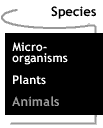
Wetlands:
Species -- Animals
Wetlands animals often rely on wetlands plants, as well as other animals,
as food resources. For example, crayfish live in wetlands; raccoons live
near wetlands so they can eat the crayfish; and panthers live near wetlands
so that they can eat the raccoons. Similar food chains tie many animals to
wetlands.
Many wetlands animals have also developed complex adaptations that enable and sometimes even require them to live in wetlands. For example, amphibians and some insects lay their eggs in water. These eggs hatch and the emerging larva have gills through which they "breathe" oxygen from the water. The larva grow and undergo a metamorphosis into air-breathing terrestrial adults. Once adults, these organisms continue to live their lives near aquatic ecosystems such as a wetlands so that they can lay their eggs in the water.
Common types of wetlands animals include:
insects small invertebrates that generally have three body segments, only three pairs of legs, and often one or two pairs of wings; for example, butterflies and beetles.
reptiles air-breathing, cold-blooded, vertebrates; for example, alligators, snakes, and turtles.
amphibians cold-blooded vertebrates that have gilled aquatic larvae and air-breathing adults; for example, salamanders and frogs.
mammals warm-blooded vertebrates that nourish their young with milk secreted by mammary glands and generally have hairy skin; for example, raccoon and deer.
birds warm-blooded vertebrates that have wings and feathers; for example, ducks and great blue herons. Photo: Great blue heron. Photo courtesy of Robert Coggeshall, Youngstown, Ohio.
spiders small, silk-spinning invertebrates that have two body segments and four pairs of legs.
fish cold-blooded, aquatic vertebrates; for example, trout and bass.
shellfish aquatic invertebrates that have shells; for example, shrimp.
For more images and information on some of these wetlands animals, visit Life in Wetlands.
Overview
..|..
Species
..|..
Functions..
..|..
Management
Microorganisms
/ Plants / Animals
Glossary
..|..
Related
Links
..|..
References
|..PBL
Model
Home ..|.. Teacher Pages ..|.. Modules & Activities
HTML code by Chris
Kreger
Maintained by ETE Team
Last updated
April 28, 2005
Some images © 2004 www.clipart.com
Privacy Statement and Copyright © 1997-2004 by Wheeling Jesuit University/NASA-supported Classroom of the Future. All rights reserved.
Center for Educational Technologies, Circuit Board/Apple graphic logo, and COTF Classroom of the Future logo are registered trademarks of Wheeling Jesuit University.

